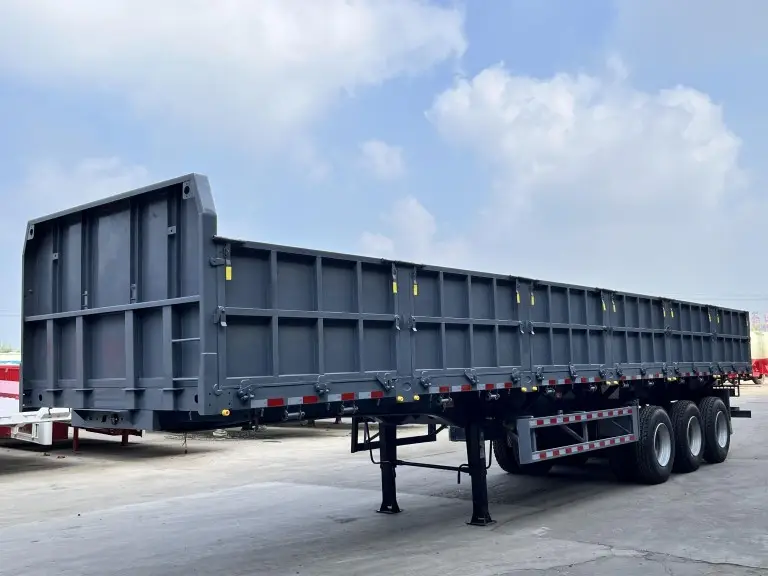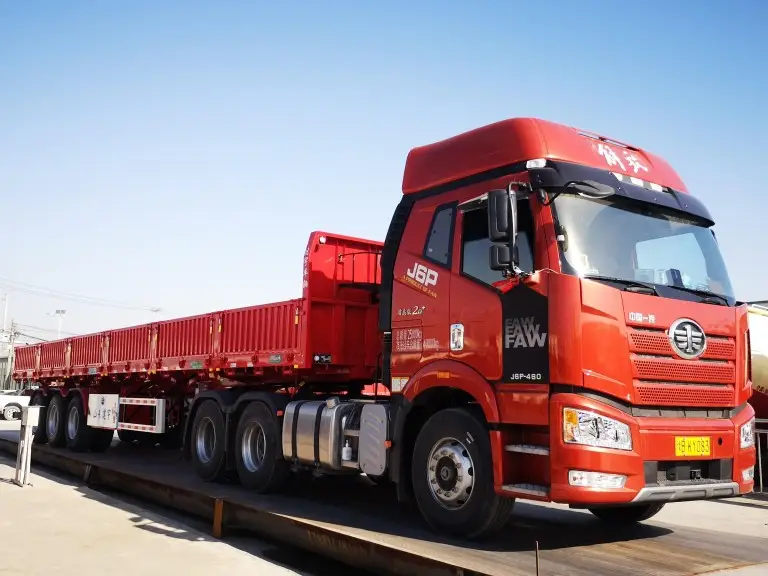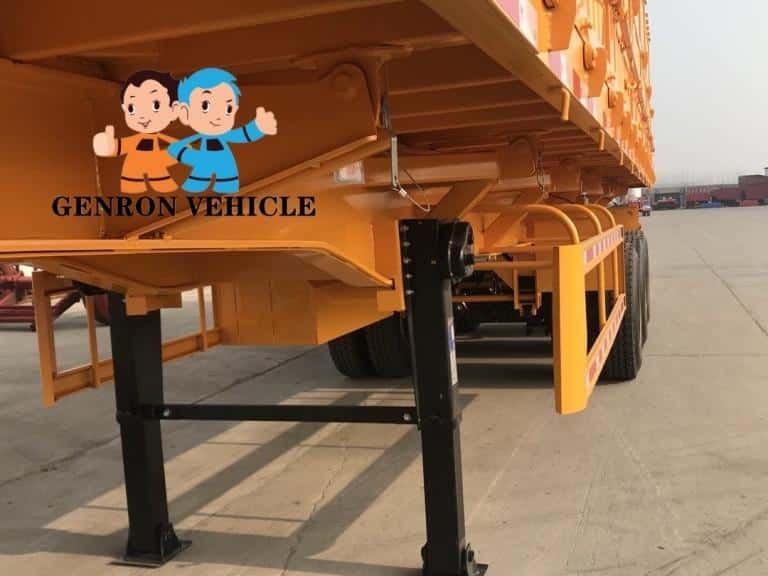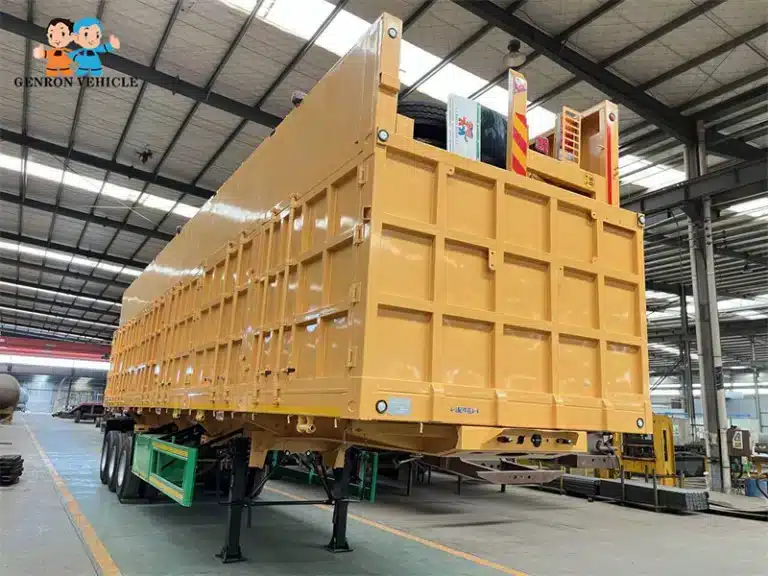Imagine a method that can completely revolutionize the transportation of bulk materials in confined spaces. Genron’s side tipper trailers are precisely such an innovative solution. Through their unique hydraulic system, these trailers can effortlessly lift one side of the body, achieving fast and efficient cargo unloading. Whether it’s gravel, sand, or grain, this design demonstrates exceptional operational flexibility in limited spaces.
This versatile trailer is particularly suitable for industries such as construction, mining, agriculture, and waste management. It not only enhances unloading efficiency but also provides businesses with a safer and more convenient option for handling loose materials. In this guide, we will delve into the mechanical principles, practical applications, and significant advantages of side tipper trailers, offering practical references and insights for enterprises looking to optimize their operations.
Table of Contents
What Are Side Tipper Trailers?
Side tipper trailers are specialized equipment designed for efficient transportation and unloading of bulk materials. Their unique feature lies in the hydraulic system that tilts the body sideways, allowing for quick unloading even in space-constrained environments.
The core design of this trailer includes three key components: a sturdy and durable body, a powerful hydraulic system, and a reinforced heavy-duty chassis. The body is meticulously designed to withstand the high-intensity demands of heavy-duty applications; the hydraulic system provides strong power for the sideways tilting of the body; the reinforced chassis structure ensures stability and structural integrity throughout loading, transportation, and unloading processes. These components work in synergy, making side tipper trailers an efficient tool for handling bulk materials (such as gravel, sand, or grain), especially suitable for industries like construction, mining, agriculture, and waste management.
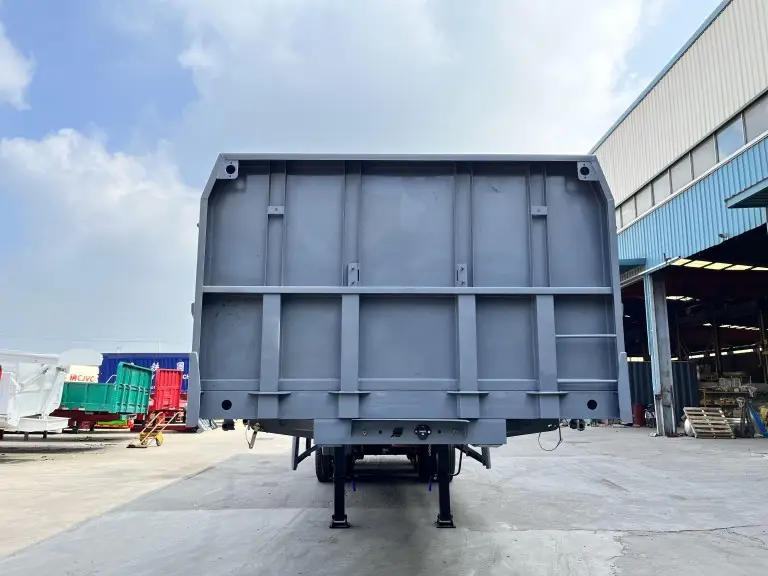
The Anatomy of Side Tipper Trailers
The anatomy of side tipper trailers is a perfect blend of strength, functionality, and innovative technology, ensuring their reliability and safety in heavy-duty applications. Below is a detailed analysis of their core structure and key components:
Trailer Body and Chassis Design
The body and chassis of side tipper trailers are designed specifically for heavy-duty applications, using high-strength steel to balance optimal weight-to-payload ratio. The body typically features a V-shaped or flat-bottom design with reinforced sidewalls to guide material flow during unloading, ensuring efficient discharge. The chassis incorporates strategic reinforcement points to maintain structural integrity through thousands of loading and unloading cycles. This optimized design not only enhances the trailer’s stability on uneven terrain but also significantly extends its service life. As the core support of the entire trailer, the chassis not only bears the body but also provides a stable foundation for the hydraulic system, ensuring balance and safety during operations.
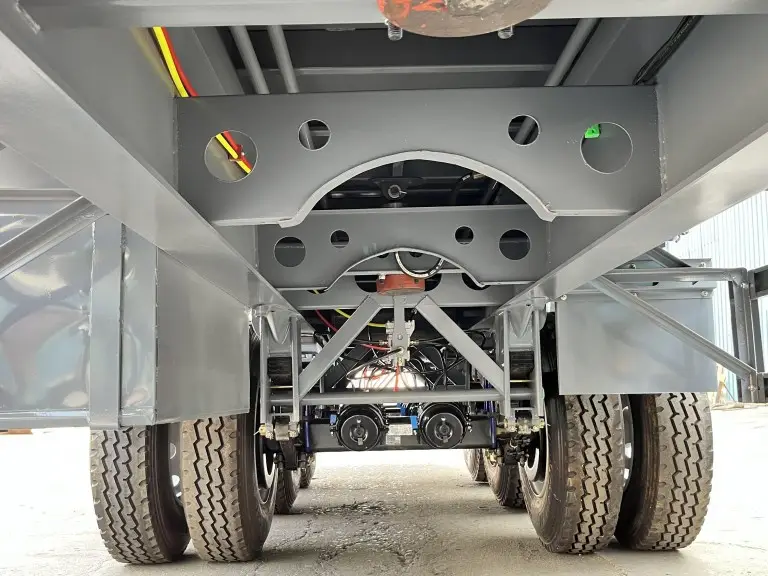
Hydraulic System Components
The hydraulic system is the power core of side tipper trailers, responsible for achieving efficient sideways tilting and unloading. This system consists of multiple components such as hydraulic cylinders, control valves, pressure regulators, and fluid reservoirs, working together to provide the necessary force and precision. The strategic positioning of hydraulic cylinders optimizes leverage and lifting capacity, typically operating at 2500 PSI with a flow rate of 25-30 gallons per minute, ensuring smooth operations. Pumps and valves are responsible for generating and regulating pressure, while actuators directly drive the tilting motion of the body, forming an efficient power chain. This design allows operators to precisely control the unloading process in confined spaces, avoiding accidents.
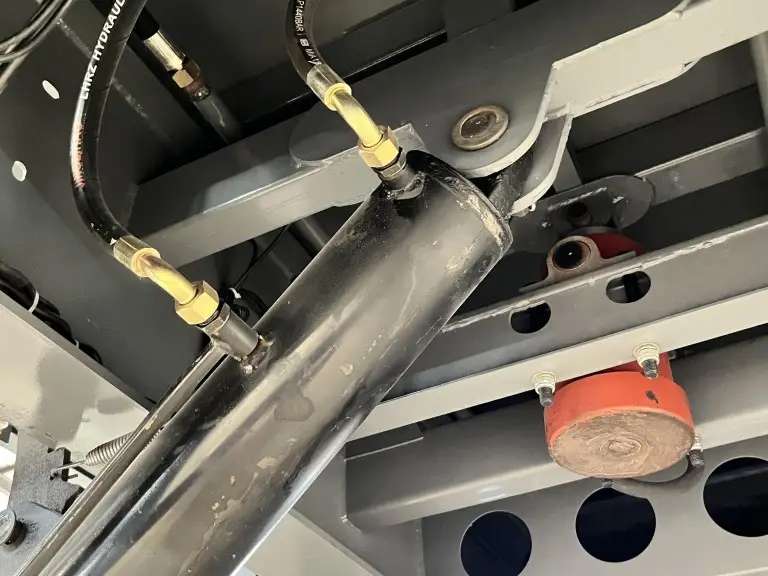
Safety Features and Mechanisms
Modern side tipper trailers integrate a variety of safety features to ensure operational reliability and safety. These include:
- Tilt angle limiters: Prevent excessive tilting of the body that could lead to rollover.
- Proximity sensors: Detect obstacles in the unloading area to avoid collisions.
- Emergency stop functions: Quickly halt operations in case of abnormalities.
- Hydraulic pressure monitoring systems: Real-time monitoring of system pressure to prevent overload.
These safety mechanisms can automatically detect abnormal resistance during the tilting cycle, ensuring a safe and controlled unloading process. For example, in mining environments handling heavy ores, these features significantly reduce risks. Compared to traditional rear-end tipping methods, the side tipper design performs superiorly on unstable ground, effectively reducing the risk of tipping over.
By combining robust body design, advanced hydraulic systems, and comprehensive safety features, side tipper trailers provide reliable and efficient solutions for industries such as construction, mining, agriculture, and waste management. We continue to innovate and improve to meet the increasingly diverse needs of our customers.
How Do Side Tipper Trailers Work?
The operational efficiency of side tipper trailers is attributed to their hydraulic system, which plays a crucial role in the unloading process. This system converts stored hydraulic energy into powerful mechanical force, enabling controlled unloading of heavy loads, with the entire process easily managed by the operator from the cab, who can start or pause the tipping action at any time to adapt to different scenarios. This method is particularly suitable for handling bulk cargoes like gravel, sand, or crops, offering higher safety and precision especially in space-limited areas.
The hydraulic system of side tipper trailers is a complex mechanism that converts stored hydraulic energy into powerful mechanical force. This allows operators to control heavy-load unloading with minimal effort. The system draws hydraulic fluid from the reservoir, pressurizes it through a pump, typically powered by the truck’s PTO. Then, the pressurized fluid is directed to hydraulic cylinders located between the chassis and the body. The hydraulic system is designed to provide precise control over the tilting process, allowing for partial unloading or adjustments to the trailer position. When activated, the hydraulic cylinders extend, lifting one side of the body while the opposite side remains anchored.
Step-by-Step Tilting Process
The tilting process of side tipper trailers is meticulously designed to ensure efficient and safe unloading of bulk materials. Below are the detailed operational steps:
- Preparation Phase: The tilting operation begins with positioning the trailer. The operator must ensure the trailer is in the correct position, with sufficient clearance around it, and stable ground conditions to avoid accidents during tilting.
- Activating the Hydraulic System: The operator activates the hydraulic system via the control panel in the cab. The hydraulic cylinders begin to extend, gradually lifting one side of the body. At this point, power is supplied by the truck engine through the power take-off (PTO) device, ensuring efficient system operation.
- Initial Lifting Phase: In the initial stage of tilting, the action of the hydraulic cylinders breaks the static friction of the load, causing the material to start moving toward the unloading side. This phase’s smooth start design avoids sudden impacts, ensuring operational safety and stability.
- Tilting and Unloading: As the hydraulic cylinders extend further, the body tilting angle gradually increases to 40-45 degrees, and the material slides out in a controlled manner along the body. The hydraulic system provides precise control throughout the process, allowing the operator to adjust the tilting angle and unloading rate as needed. This flexibility is particularly important in confined spaces, effectively preventing material buildup or accidental spillage.
- Completing Unloading and Reset: After unloading is complete, the hydraulic system reverses the flow, retracting the cylinders and smoothly returning the body to the horizontal transport position. The material naturally slides out along the length of the body, while the other side is secured to the chassis via hinges, ensuring stability and safety throughout the process.
- Efficient Cycle: The entire tilting cycle is typically completed within two minutes, significantly improving efficiency compared to traditional unloading methods. This fast and reliable operation makes side tipper trailers an ideal choice for industries such as construction, mining, and agriculture.
Through precise hydraulic control and smooth tilting design, side tipper trailers not only enhance unloading efficiency but also provide operators with higher safety and flexibility, becoming an efficient solution for bulk material transportation and unloading.
Key Benefits of Side Tipper Trailers
With their unique design, side tipper trailers demonstrate significant advantages in operational efficiency and safety, becoming a powerful alternative to traditional dump trucks. Below is a summary of their main benefits:
Significant Improvements in Operational Efficiency
The side unloading design of side tipper trailers greatly enhances unloading efficiency, performing exceptionally well especially in confined spaces or areas with limited access. Compared to traditional rear unloading systems, its design provides operators with a clearer view, allowing direct observation of the unloading process from the cab without worrying about obstructed sightlines.
- Faster unloading cycles: Unloading speed increases by up to 30%, significantly shortening operation time.
- Dynamic unloading capability: Supports unloading while the vehicle is moving slowly, further improving efficiency.
- Precise material placement: Thanks to clear visibility, operators can more accurately control the unloading position of materials.
- Reduced transportation trips: In high-intensity industries like mining, this efficiency boost is particularly evident, effectively reducing the number of round trips.
Comprehensive Improvements in Safety and Stability
Modern side tipper trailers are equipped with advanced stability control systems that monitor the trailer’s position in real-time and automatically adjust hydraulic pressure as needed to ensure operations remain within safe parameters. These features are particularly important on uneven terrain, effectively preventing rollover accidents.
- Stability control: Integrated stability control systems provide additional safety assurance during operations.
- Reduced accident risks: Through automatic hydraulic pressure adjustments and real-time monitoring, operational risks are significantly lowered.
- Adaptability to complex terrain: On rugged or uneven ground, the design of side tipper trailers maintains higher stability.
Feature Comparison: Side Tipper Trailers vs. Traditional Dump Trucks
| Feature | Side Tipper Trailers | Traditional Dump Trucks |
|---|---|---|
| Unloading Mechanism | Side unloading | Rear unloading |
| Visibility During Unloading | Clear view from the cab | Unloading point view may be obstructed |
| Stability Control | Advanced stability control systems | Limited stability control |
Conclusion
With advanced hydraulic systems and unique structures designed specifically for bulk material transportation, side tipper trailers are completely revolutionizing operations in this field. In this article, we have delved into the core components, working principles, various types, and key advantages of side tipper trailers, fully demonstrating their significant improvements in efficiency, safety, and versatility compared to traditional dump trucks.
Genron, with its rich manufacturing experience, is committed to designing and producing high-quality tipper semi trailers. We always prioritize innovation and customer satisfaction, continuously optimizing product designs through real user feedback and rigorous testing to ensure every trailer meets the highest industry standards in performance, durability, and safety.
As the demands for bulk material transportation continue to evolve, side tipper trailers will continue to lead industry innovation. In the future, with ongoing advancements in materials technology, hydraulic systems, and safety features, these trailers will demonstrate even stronger capabilities in handling demanding applications. Whether you need standardized products or tailored solutions, our team of engineering experts is always ready to develop the ideal semi-trailer for you, helping you maximize efficiency and capabilities in bulk material transportation.
FAQs
What are the benefits of using a multi-axle configuration in a side dump trailer?
A multi-axle configuration provides improved stability, increased load capacity, and better weight distribution, making it ideal for heavy-duty applications and uneven terrain. This design complies with road regulations and enhances overall durability.
How do side tipper trailers compare to traditional dump trucks in terms of efficiency?
Side tipper trailers provide improved efficiency due to their ability to unload materials quickly and easily, reducing labor costs and increasing productivity. Studies show they can achieve 25-30% faster cycle times.
What safety features are typically included in the design of a tipper trailer?
Tipper trailers typically feature safety mechanisms such as load restraints, stability systems, and emergency shutdowns to ensure safe operation and minimize accident risks. These functions include pressure monitoring and proximity sensors.
Can side tipper trailers be customized to meet specific industry needs?
Yes, side tipper trailers can be customized to meet the unique requirements of various industries such as construction, mining, and agriculture, through modifications like specialized bodies and suspension systems.
What is the role of the suspension system in a dump trailer?
The suspension system plays a crucial role in maintaining the stability and ride quality of a dump trailer, ensuring safe transportation of materials and reducing vehicle wear. Regular inspections can extend its lifespan.
How do interlink side tipper systems improve operational efficiency?
Interlink side tipper systems allow for the transportation of larger volumes of materials, streamlining logistics and reducing the need for multiple trips, thereby improving overall operational efficiency. In mining, this reduces costs.

